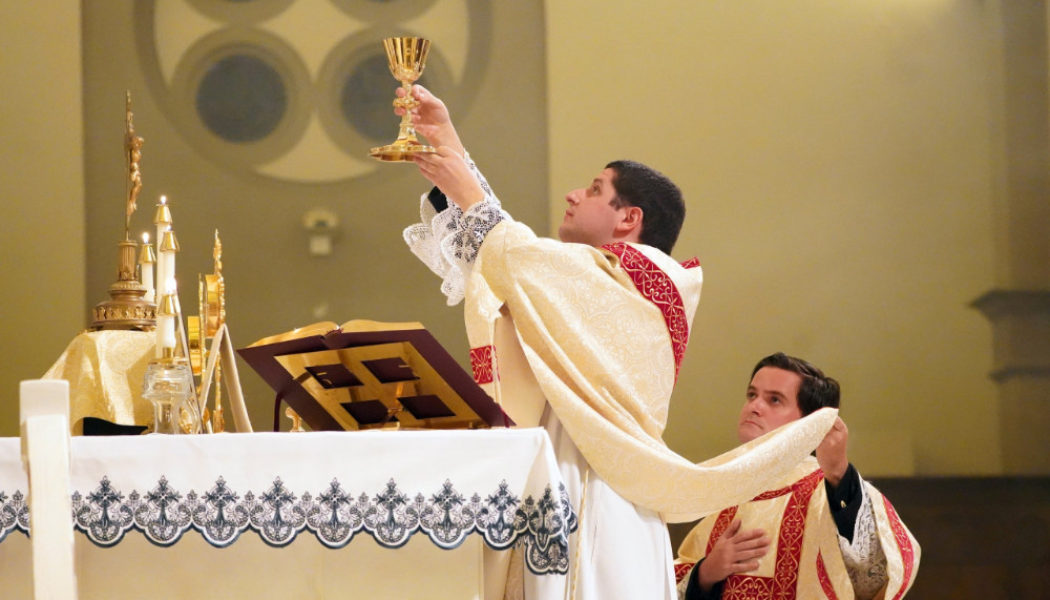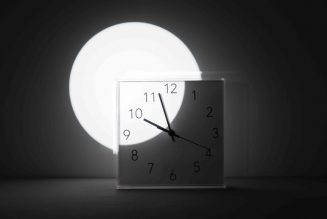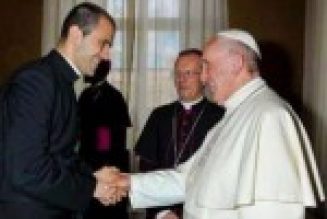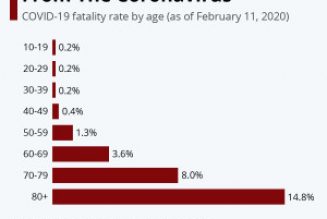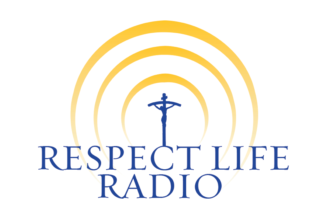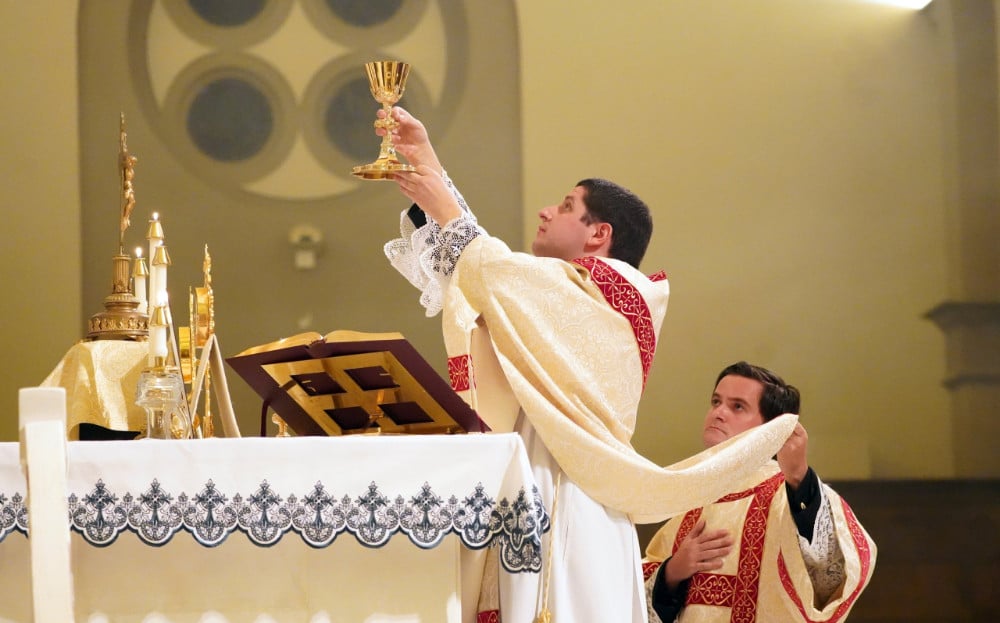
Father Alessandro da Luz elevates the chalice as he celebrates a traditional Latin Mass Aug. 11, 2020, at Our Holy Redeemer Church in Freeport, N.Y. (CNS photo/Gregory A. Shemitz)
In the wake of the deaths of Pope Benedict XVI and Australian Cardinal George Pell, media outlets — both Catholic and secular — have featured significant commentary about the political and theological divisions in the Catholic Church. One month ago, those themes were taken up in the Wall Street Journal. “American Catholic priests are becoming more conservative, even as their flocks are becoming more liberal,” wrote Francis Rocca on Dec. 18.
To further investigate the claims of the article, Our Sunday Visitor consulted Stephen White, director of the Catholic Project at The Catholic University of America on the question. Under White’s direction, the Catholic Project released the initial findings of the largest survey of Catholic priests in 50 years this fall.
A rise in conservatism
Our Sunday Visitor: An article appeared last month in the Wall Street Journal, which is alleging or is arguing from data produced by the Austin Institute that Catholic priests are becoming more conservative. Does that square with your experience?
Stephen White: It does; there’s a lot of anecdotal evidence that suggests this. The Austin Institute data suggest this and our data suggest something similar. From our data, it seems that the younger a priest is, the more likely he is to be conservative. Our survey asked priests about whether they saw themselves, on a scale from “very conservative” to “very progressive,” both theologically and politically, and our data suggest that the younger a priest is, the more likely he is to be theologically and politically conservative.
Our Sunday Visitor: But what does “conservative” mean? Does this mean younger priests identify as politically conservative, theologically conservative or both?
Stephen White: Yes, we asked both questions, and younger priests are both more politically conservative and more theologically conservative. What is interesting from our study, however, is that we also asked bishops whether they saw these differences among their priests as a problem. Of the bishops that we asked, 48% said they saw the political differences among priests as either something of a problem or a significant problem. And 46% said the same about theological differences. So the bishops are aware of the differences. Some of them see it as an issue, but we didn’t have a lot of follow up questions on that. So it is a real thing, and it is something that bishops are aware of and that they’re keeping their eye on.
What does ‘conservative’ mean?
Our Sunday Visitor: Do you get the sense that the American hierarchy has grown more conservative, that the American bishops are more conservative than they once were as a body? In other words, if America’s priests are growing more conservative, do you think America’s bishops are growing more conservative?
Stephen White: I think that’s probably true. One of the things that’s worth paying attention to is what we mean by conservative and what we mean by progressive. And we can get into that a little bit more, because what a priest or a bishop means when he says that about himself might not be what the Wall Street Journal means when it repeats something that was in a different survey. So there’s some qualification there that I think paints a bit more complex and nuanced a picture than just “priests are getting more conservative.”
Our Sunday Visitor: Well then, let’s go ahead and talk about that, because I think that is interesting. So in your survey, how did you use those terms in a way that would be different from how the Wall Street Journal has used them?
Stephen White: We asked priests to rank themselves on a five-point scale, you know, one end is “very progressive” and the other is “very conservative.” And as I said earlier, the youngest cohort of priests gave the most conservative answer, both in terms of politics and in terms of theology. So that corresponds to the Austin Institute’s report featured in the Wall Street Journal, which was actually from a year ago. Our data has a bigger sample, and it’s a little bit newer, but it shows a similar trend. That trend seems to be real.
It’s also interesting to note that the youngest cohorts of priests in the United States also happened to be the most racially diverse. Consider, for example, the oldest cohort of priests in the United States — those who are 75 and older in our survey — 95% of them were white. And that’s not a small cohort; that’s about 17% of the priests who responded to our survey. By comparison, the youngest cohort — 40 and under — was about 22% of the priests. They’re roughly comparable in size, these two cohorts. And while 95% of the oldest cohort was white, that drops to about 63% among the youngest cohort. That cuts across some of the narratives you might expect. So younger priests do tend to be more conservative politically and theologically, but they also tend to be more racially diverse.
Relationship with the pope
Our Sunday Visitor: And what about the relationship between these younger, conservative priests and Pope Francis?
Stephen White: The Wall Street Journal picks up a question from the Austin Institute study about whether priests “approve” of the job that Pope Francis is doing. The Austin Institute report points out that it’s a bit of an odd question to ask priests if they approve of the successor of St. Peter. We didn’t ask that question, but we did ask priests how much they value accountability to God, to the pope, to their bishops, to the laity and so forth. We did ask, how much do you value accountability to Pope Francis?
And the numbers that we got were interesting because it suggests that while younger priests tend to be more conservative politically and theologically, and while I have no reason to doubt the Austin Institute numbers — assuming that those are true, that young priests don’t approve or disapprove of Pope Francis at a higher rate than older cohorts — it seems that they also according to our data still value their accountability to him. In other words, they might not like or agree with decisions that he makes as pope, but they still value their accountability to him as the pope. One way to interpret that, and I would interpret it this way, is that we’re seeing a healthy relationship between obedience and loyalty to a pope. That’s my word, not the survey’s word. It should be edifying, I think, to see that even priests who might not think that some of Pope Francis’ decisions are the decisions they would like to have seen, still value their accountability to him.
Sexual abuse crisis
Our Sunday Visitor: And what about the clerical sexual abuse crisis? Are there differences in how younger conservative priests approach it? Do the generations have similar or different responses to the crisis?
Stephen White: We did get some interesting results when we asked priests what they saw as the causes of the abuse crisis. Those answers did vary significantly by age. Since age correlates to a certain degree with conservative or progressive, then there’s some correlation in those responses as well.
Of all the causes of the abuse crisis we offered that priests could select — and they could select more than one — the only one in which the oldest cohort (priest 75 and older) selected more was celibacy. And even then, it was a very small percentage. Of all the possible answers, across the board, celibacy scored by far the lowest. So if you ask priests what caused the abuse crisis, they’ll give you lots and lots of different answers. But priests are in near unanimity that celibacy is not really a cause of the abuse crisis.
The youngest cohort, those under the age of 45, attribute lots of things as causes of the abuse crisis. For example, more than 70% of priests of the youngest cohort said that poor seminary formation regarding sexuality was a cause of the abuse crisis. That was the highest score, by the way. Homosexual subcultures in some seminaries, dioceses and religious institutes scored fairly high among the youngest cohort and then declines fairly significantly. So about 70% of the youngest cohort said that was a cause, whereas less than 30% of the oldest cohorts saw that as a cause. Poor psychological screening of seminarians: Almost 70% of the youngest cohort attributed that as a cause. That number drops to between 40 and 50% among the oldest cohort. There are four core cohorts here, so the middle cohorts line up more or less on a linear scale between the high and the low. A lack of transparency on the part of bishops and of major superiors: Again, the youngest priests were close to 70% saying that that was a cause of the crisis, while less than 50%, right about 40% of the oldest cohort, said that was a cause. The belief that perpetrators of child sexual abuse could be cured psychologically: Just over 60% of the youngest cohort said that was one of the causes and almost 50% of the oldest cohort thought that was one of the causes. So that’s an indicator where the highest and lowest scores are fairly clumped together. So it seems that about 50 to 55% of priests think that was a cause, and that’s across the board. There’s not a big difference there.
One thing that’s really interesting in addition to the celibacy question, which almost everyone thought wasn’t a big cause, was the devil and his minions. I think that wording is ours. The idea is that there is a spiritual element to this that involved demons. More than 70% of the youngest cohort said that that was one of the causes, and again, they said that there were a lot of causes, but that was one of the causes. Twenty percent or just under 20% of the oldest cohorts on that. There’s a huge gap there. In fact, of all the indicators that might be the biggest gap between the youngest and the oldest cohort. Was there a demonic role in this? Of the youngest priests, a significant majority say yes that was one of the causes. But very few or relatively few, only 20% or 19% of the oldest cohort, thought that was a cause of the abuse crisis. It’s a bit interesting. There’s a lot of reasons that that might be, but there’s a lot of room for speculation here.
Our Sunday Visitor: Can you speak to the relationship that these younger conservative priests have with Pope Francis?
Stephen White: In the Wall Street Journal, Father Thomas Reese drew a strong connection between young priests who were indoctrinated in total loyalty to the pope, who dropped their loyalty when a new pope was elected. I think that’s not the case. The data does not bear that out. It’s true that younger priests are more conservative. They’re aware of this. Their bishops are aware of this. But the idea that you don’t necessarily approve of everything the pope does does not in any sense equate — and the data do not say that equates — to some kind of disloyalty. It’s simply not the case.
Our Sunday Visitor: It seems to me that there’s a significant implication in the Wall Street Journal article — namely, that the disparity between priests and people has caused priests to be unhappy. Are these younger priests unhappy?
Stephen White: The Austin Institute survey, our survey and a whole host of surveys of Catholic priests going back quite a long time consistently show that priests in the United States are very happy in their ministry. They’re very satisfied. They really are flourishing, and they’re doing very well even given all the pressures and difficult circumstances that they’re under. I think that’s always worth emphasizing, because if we forget that, we just get the wrong picture of priests. By and large, priests are doing very well and are very happy.
Father Patrick Briscoe, OP, is editor of Our Sunday Visitor. Follow him on Twitter @PatrickMaryOP.
